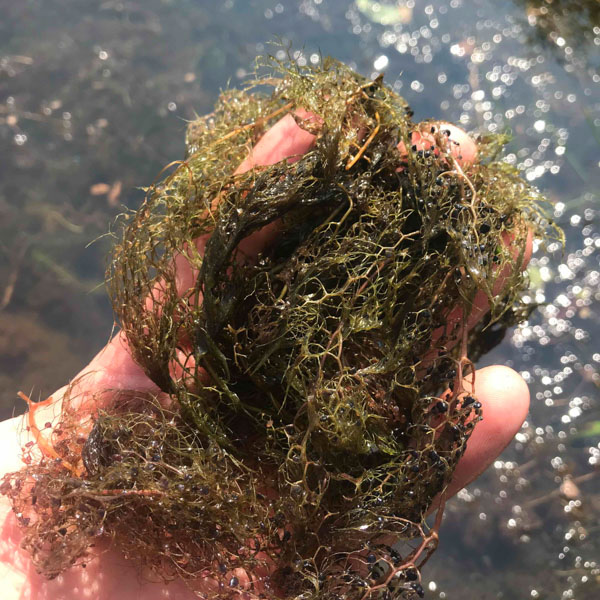Bladderwort
Bladderwort, Utricularia spp, gets its name from the small bladder-like slimy balls that are attached to the leaves . From the stems, tiny green to brown leaves form in a net-like pattern. Bladderwort also produces small yellow or lavender flowers that emerge above the water.
Unlike many other pond weeds, bladderwort is free floating. It easily spreads throughout the pond because there is no root system to anchor bladderwort stems in place. Bladderwort is typically found in calm water.
Fun fact: Bladderwort is a carnivorous plant! Bladders have a small trap to capture micro-organisms in water. The stem of bladderwort can be covered by hundreds of traps. What type of prey does bladderwort capture? Bladderwort captures small prey, including mosquito larvae. Bladderwort's bladder-like traps range in size from 0.2mm to 1.2cm.
Most aquatic plants are uptaking nutrients for food through their roots. Bladderwort consumes food by capturing aquatic organisms.

What are the effects of bladderwort on aquatic ecosystems?
Bladderwort exerts various effects on its surroundings. The dense growth of bladderwort creates intricate mats, which have implications for water circulation within the ecosystem. These mats can limit the movement of water, potentially disrupting natural flow patterns and hindering the exchange of nutrients and oxygen. As a result, the altered water circulation can negatively impact the overall health and balance of the aquatic ecosystem.
Additionally, bladderwort's vigorous growth can outcompete native vegetation by occupying available space and resources. This overcrowding often leads to reduced biodiversity as native aquatic plants struggle to thrive under the presence of bladderwort. The displacement and decline of native vegetation can disrupt the ecological balance within the ecosystem, affecting various organisms that depend on these native plants for food, shelter, and other vital resources.
Furthermore, the proliferation of bladderwort can contribute to the development of unpleasant odors in the aquatic environment. The dense mats it forms provide an ideal breeding ground for bacteria and decomposition processes, resulting in the release of organic compounds that can generate foul-smelling odors. This not only affects the overall aesthetics of the ecosystem but may also have consequences for organisms and human activities that rely on clean and odor-free water.
Bladderwort's ability to propagate through both seeds and fragmentation adds another layer of complexity to managing its presence within aquatic ecosystems. Its multiple reproductive pathways make it challenging to effectively control bladderwort populations and limit their expansion.

Non-chemical control:
Bladderwort can be removed with rakes. However, since weeds will reproduce through fragmentation, it is important to remove all vegetation. Bladderwort has no root system, so once removed, you don’t have to worry about regrowth from roots left behind.
Grass Carp can also be used to control Bladderwort.
Chemical treatment options:
Since removing all of the bladderwort plant fragments can be very difficult, EPA-approved aquatic herbicides are often necesary for complete control.
Harvester provides fast control of bladderwort. To improve results mix with Cutrine (1 qt Harvester, 1 gal Cutrine). This is a contact herbicide. Must come in contact in order to kill.
Sonar provides a long term management solution for bladderwort. Sonar reacts slowly, taking 30-60 days for results. The entire pond must be treated for success. This treatment option is only for ponds with little or no flow coming into the pond. Sonar AS, and Sonar RTU are available options.
Propeller is a complete pond treatment for managing bladderwort. Pond volume must be known for proper application. Only for ponds with little to no flow.
Granular herbicides are NOT recommended because bladderwort is not a rooted weed.
Bladderwort Control
Need help identifying your POND WEED or How Much Treatment To Use?
Click Here To Submit Your Pond Help Request
